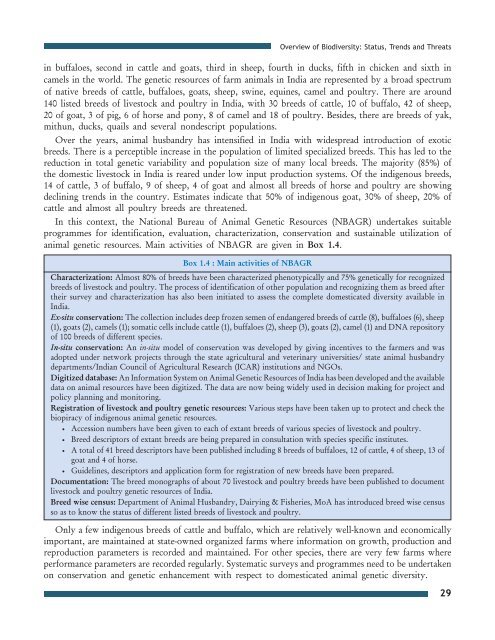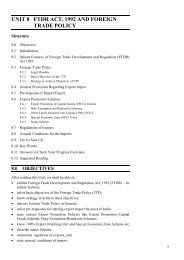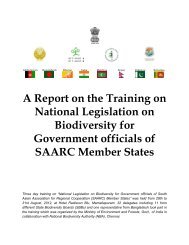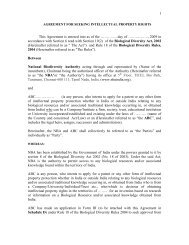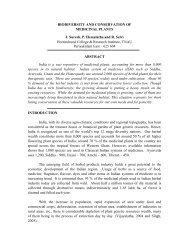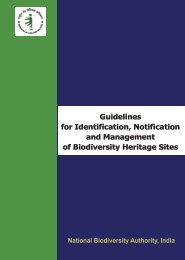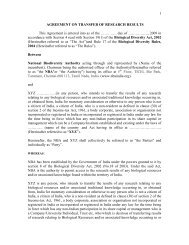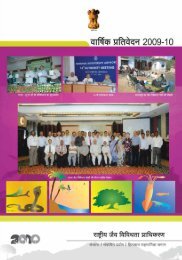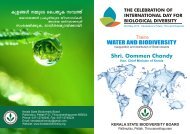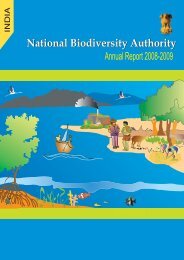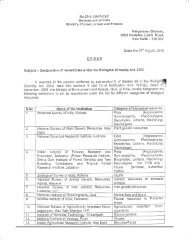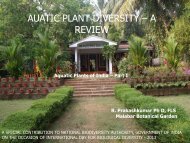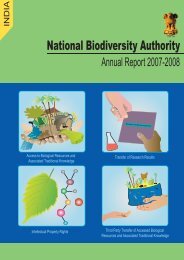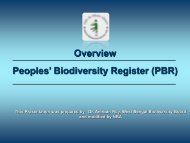Part 1 - English version (PDF) - Convention on Biological Diversity
Part 1 - English version (PDF) - Convention on Biological Diversity
Part 1 - English version (PDF) - Convention on Biological Diversity
Create successful ePaper yourself
Turn your PDF publications into a flip-book with our unique Google optimized e-Paper software.
in buffaloes, sec<strong>on</strong>d in cattle and goats, third in sheep, fourth in ducks, fifth in chicken and sixth in<br />
camels in the world. The genetic resources of farm animals in India are represented by a broad spectrum<br />
of native breeds of cattle, buffaloes, goats, sheep, swine, equines, camel and poultry. There are around<br />
140 listed breeds of livestock and poultry in India, with 30 breeds of cattle, 10 of buffalo, 42 of sheep,<br />
20 of goat, 3 of pig, 6 of horse and p<strong>on</strong>y, 8 of camel and 18 of poultry. Besides, there are breeds of yak,<br />
mithun, ducks, quails and several n<strong>on</strong>descript populati<strong>on</strong>s.<br />
Over the years, animal husbandry has intensified in India with widespread introducti<strong>on</strong> of exotic<br />
breeds. There is a perceptible increase in the populati<strong>on</strong> of limited specialized breeds. This has led to the<br />
reducti<strong>on</strong> in total genetic variability and populati<strong>on</strong> size of many local breeds. The majority (85%) of<br />
the domestic livestock in India is reared under low input producti<strong>on</strong> systems. Of the indigenous breeds,<br />
14 of cattle, 3 of buffalo, 9 of sheep, 4 of goat and almost all breeds of horse and poultry are showing<br />
declining trends in the country. Estimates indicate that 50% of indigenous goat, 30% of sheep, 20% of<br />
cattle and almost all poultry breeds are threatened.<br />
In this c<strong>on</strong>text, the Nati<strong>on</strong>al Bureau of Animal Genetic Resources (NBAGR) undertakes suitable<br />
programmes for identificati<strong>on</strong>, evaluati<strong>on</strong>, characterizati<strong>on</strong>, c<strong>on</strong>servati<strong>on</strong> and sustainable utilizati<strong>on</strong> of<br />
animal genetic resources. Main activities of NBAGR are given in Box 1.4.<br />
Box 1.4 : Main activities of NBAGR<br />
Overview of Biodiversity: Status, Trends and Threats<br />
Characterizati<strong>on</strong>: Almost 80% of breeds have been characterized phenotypically and 75% genetically for recognized<br />
breeds of livestock and poultry. The process of identificati<strong>on</strong> of other populati<strong>on</strong> and recognizing them as breed after<br />
their survey and characterizati<strong>on</strong> has also been initiated to assess the complete domesticated diversity available in<br />
India.<br />
Ex-situ c<strong>on</strong>servati<strong>on</strong>: The collecti<strong>on</strong> includes deep frozen semen of endangered breeds of cattle (8), buffaloes (6), sheep<br />
(1), goats (2), camels (1); somatic cells include cattle (1), buffaloes (2), sheep (3), goats (2), camel (1) and DNA repository<br />
of 100 breeds of different species.<br />
In-situ c<strong>on</strong>servati<strong>on</strong>: An in-situ model of c<strong>on</strong>servati<strong>on</strong> was developed by giving incentives to the farmers and was<br />
adopted under network projects through the state agricultural and veterinary universities/ state animal husbandry<br />
departments/Indian Council of Agricultural Research (ICAR) instituti<strong>on</strong>s and NGOs.<br />
Digitized database: An Informati<strong>on</strong> System <strong>on</strong> Animal Genetic Resources of India has been developed and the available<br />
data <strong>on</strong> animal resources have been digitized. The data are now being widely used in decisi<strong>on</strong> making for project and<br />
policy planning and m<strong>on</strong>itoring.<br />
Registrati<strong>on</strong> of livestock and poultry genetic resources: Various steps have been taken up to protect and check the<br />
biopiracy of indigenous animal genetic resources.<br />
Accessi<strong>on</strong> numbers have been given to each of extant breeds of various species of livestock and poultry.<br />
Breed descriptors of extant breeds are being prepared in c<strong>on</strong>sultati<strong>on</strong> with species specific institutes.<br />
A total of 41 breed descriptors have been published including 8 breeds of buffaloes, 12 of cattle, 4 of sheep, 13 of<br />
goat and 4 of horse.<br />
Guidelines, descriptors and applicati<strong>on</strong> form for registrati<strong>on</strong> of new breeds have been prepared.<br />
Documentati<strong>on</strong>: The breed m<strong>on</strong>ographs of about 70 livestock and poultry breeds have been published to document<br />
livestock and poultry genetic resources of India.<br />
Breed wise census: Department of Animal Husbandry, Dairying & Fisheries, MoA has introduced breed wise census<br />
so as to know the status of different listed breeds of livestock and poultry.<br />
Only a few indigenous breeds of cattle and buffalo, which are relatively well-known and ec<strong>on</strong>omically<br />
important, are maintained at state-owned organized farms where informati<strong>on</strong> <strong>on</strong> growth, producti<strong>on</strong> and<br />
reproducti<strong>on</strong> parameters is recorded and maintained. For other species, there are very few farms where<br />
performance parameters are recorded regularly. Systematic surveys and programmes need to be undertaken<br />
<strong>on</strong> c<strong>on</strong>servati<strong>on</strong> and genetic enhancement with respect to domesticated animal genetic diversity.<br />
29


